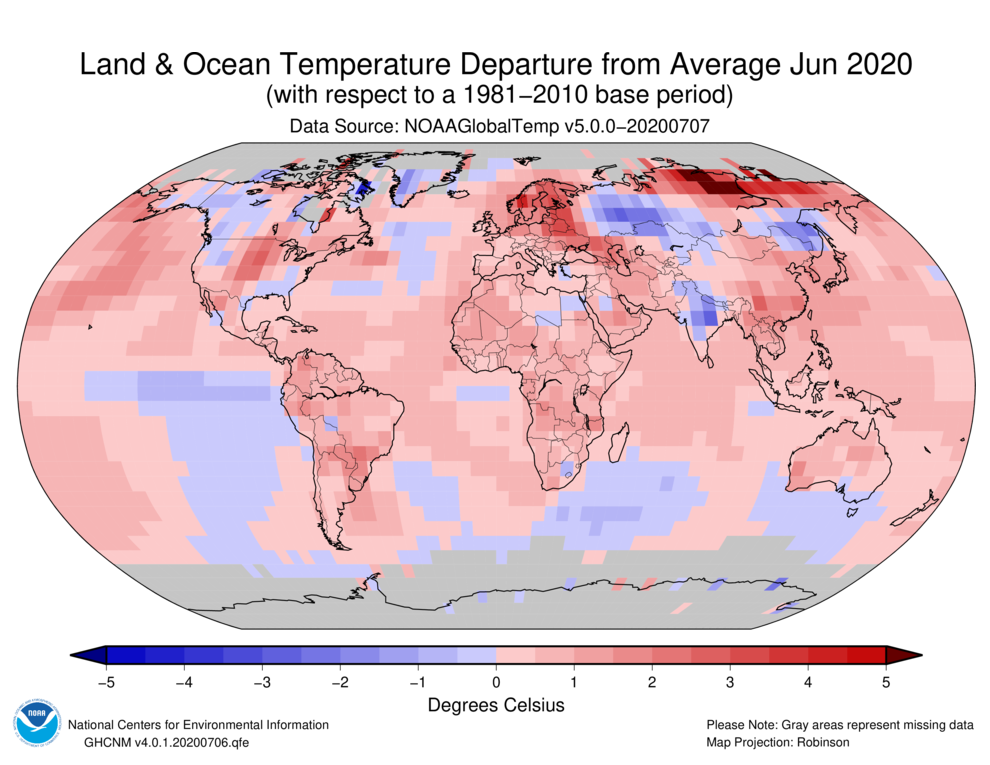Arctic heat record is like Mediterranean, says WMO – “The record is clearly indicative of warming across Siberia”

14 December 2021 (BBC News) – The highest temperature ever recorded in the Arctic, 38C (100F), has been officially confirmed, sounding “alarm bells” over Earth’s changing climate.
The World Meteorological Organization (WMO) on Tuesday verified the record, reported in the Siberian town of Verkhoyansk on 20 June last year.
The temperature was 18C higher than the area’s average daily maximum for June.
The WMO, a UN agency, said the extreme heat was “more befitting the Mediterranean than the Arctic”.
It is the first time the agency has included the Arctic Circle in its archive of extreme weather reports.
The WMO said the 38C temperature was measured at a meteorological station during “an exceptional and prolonged Siberian heatwave“. […]
The high temperatures across Siberia led to “massive sea ice loss” and played a major role in 2020 being one of the three warmest years on record, the WMO said.
The agency said its verification of the Verkhoyansk record highlighted how temperatures were increasing in a climatically important region of the world.
“This new Arctic record is one of a series of observations reported to the WMO archive of Weather and Climate Extremes that sound the alarm bells about our changing climate,” said WMO Secretary-General Petteri Taalas.
Mr Taalas told the BBC that melting snow and ice in the Russian Arctic were boosting warming.
“This is very much caused by changes in the radiation properties of the soil and the ocean… once we had snow cover, the radiation properties of the surface is very different from the dark soil or open sea,” he said. [more]
Arctic heat record is like Mediterranean, says UN
WMO recognizes new Arctic temperature record of 38⁰C
GENEVA, 14 December 2021 (WMO) – A temperature of 38°C (100.4°F) in the Russian town of Verkhoyansk on 20 June 2020 has been recognized as a new Arctic temperature record by the World Meteorological Organization (WMO).
The temperature, more befitting the Mediterranean than the Arctic, was measured at a meteorological observing station during an exceptional and prolonged Siberian heatwave. Average temperatures over Arctic Siberia reached as high as 10 °C above normal for much of summer last year, fueling devastating fires, driving massive sea ice loss and playing a major role in 2020 being one of the three warmest years on record.
“This new Arctic record is one of a series of observations reported to the WMO Archive of Weather and Climate Extremes that sound the alarm bells about our changing climate. In 2020, there was also a new temperature record (18.3°C) for the Antarctic continent,” said WMO Secretary-General Prof. Petteri Taalas.
“WMO investigators are currently seeking to verify temperature readings of 54.4°C recorded in both 2020 and 2021 in the world’s hottest place, Death Valley in California, and to validate a new reported European temperature record of 48.8°C in the Italian island of Sicily this summer. The WMO Archive of Weather and Climate Extremes has never had so many ongoing simultaneous investigations,” said Prof. Taalas.
The Arctic is among the fastest warming regions in the world and is heating more than twice the global average. The extreme temperature and ongoing climate change prompted a WMO panel of experts to add a new climate category “highest recorded temperature at or north of 66.5⁰, the Arctic Circle” to its international Archive of Weather and Climate Extremes. […]
“Fundamentally, this investigation highlights the increasing temperatures occurring for a climatically important region of the world. Through continued monitoring and assessment of temperature extremes, we can remain knowledgeable about the changes occurring in this critical region of the world, the polar Arctic,” said Professor Randall Cerveny, Rapporteur of Climate and Weather Extremes for WMO.
“It highlights the need for sustaining long-term observations which provide us benchmarks of the state of the climate system,” said Prof. Cerveny.
As with all WMO evaluations of extremes (e.g., temperature, pressure, wind, etc.), the extremes presented before the WMO for adjudication are ‘snapshots’ of our current climate. It is possible, indeed likely, that greater extremes will occur in the Arctic region in the future. When such observations are made, new WMO evaluation committees will be formed to verify the status of such observations as extremes.
“The record is clearly indicative of warming across Siberia,” said the noted UK climatologist and committee member Dr Phil Jones.
“Verifying records of this type is important in having a reliable base of evidence as to how our climate’s most extreme extremes are changing,” said Dr Blair Trewin from Australia’s Bureau of Meteorology and another member of the evaluation committee. [more]



